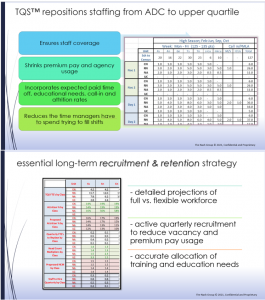What solutions are then available to improve the nursing shortage? (continued)
Group 2 is a collection of operational and recruitment and retention practices that should be embedded in all healthcare organizations.
Let us start with the operational methodologies, but first a side note: I am often told that none of these methodologies matters when “we have so many vacancies!” The flaw in that thinking is that the shortage is in part due to the widespread lack of these methodologies and that they form the core of sound long term recruitment practices and staff needs estimates for the correct places at the correct time.
- Bye bye average daily census (ADC)… it is so amazing to see most hospitals plan staffing needs based on a revenue metric than does not even count patients! Managers hiring allowances are constrained by projections of activity that miscount demand and do not account for seasonality and week variations.
- The industry needs to get past hours of care (HPPDs) and other inconsequential metrics to benchmark and plan labor needs (especially for nursing). Care is not delivered based on HPPDs, nor can staff needs be planned on a rate that is volume dependent and that ignores skill mix cost. No wonder why managers cannot effectively project recruitment needs. Instead, the industry needs to model assignments and economically size them!
- Next are the proverbial flexible workforce and divisional pools. There is a huge knowledge gap in most hospitals on how to determine the correct proportion of full vs. flexible staff (head count multipliers – HCM). The consequence of poor HCM estimates is the believe among nurse leaders and recruiters that nurses cannot be hired unless full time employment is offered. Under the correct HCM, managers will quickly discover plenty of opportunities to offer staff reduced hours, seasonal shifts, and rotational schedules.
- Nurse leaders, incentivized by poor budgets, time-and-attendance software built to support bad practices, and recruiters overwhelmed with vacancies, lack training to setup top quartile schedules (TQS) that account for retention and demand variations. Seasonal TQS plan is the proper way to account for staffing needs and most labor and activity contingencies, including census, call-ins, FMLA and attrition rates.
- TQS and HCM are fundamentals to assemble anticipatory quarterly recruitment needs (QRN). This tactic is a complete divisional recruitment plan that HR and managers can follow to stay ahead of attrition and transfers. It also helps “feeder units”, those units where staff constantly transfer from, to other areas of the hospital to maintain staff to cover their needs.
